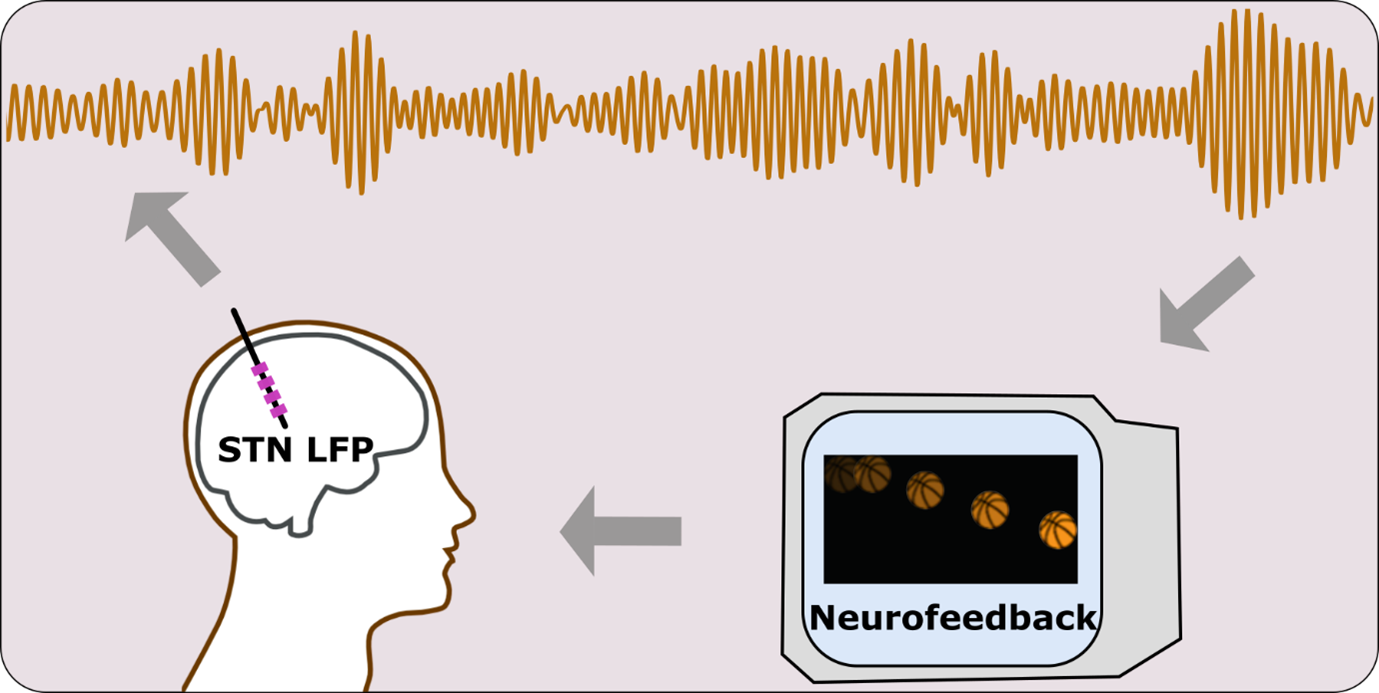LFPs and EEGs from patients with Parkinson’s disease during neurofeedback training
Task
The data were recorded from 12 human volunteers (4 females) during the participants performing a sequential neurofeedback-behaviour task with the neurofeedback reflecting the occurrence of beta bursts in the subthalamic nucleus (STN) local field potentials (LFPs) quantified in real time.
Each experimental session consisted of 30 s of rest, a block of 10 trials in the ‘Training’ condition, and a block of 10 trials in the ‘No Training’ condition. The instruction for each block was presented for 10 s before the block started. The order of training and no training blocks was randomized in each session. Each trial consisted of a 2–3 s period during which the patients were instructed to get ready, and a neurofeedback phase lasting 4–8 s followed by a cued motor task 2–3 s after the neurofeedback phase. In the training trials, the participants were instructed to keep the basketball floating at the top of the screen, which would require them to suppress the beta bursts. In the no training trials, the participants were instructed to simply pay attention to the movement of the ball displayed on the screen and get ready for the subsequent movement go-cue. In terms of the motor task, the participants were instructed to perform a thumb of finger pinch movement as fast as possible in response to the go-cue to generate a force overshooting a predefined force level (50% of the maximum voluntary force measured before starting the task).
Nine out of the twelve participants completed four sessions of the task separately with both hemispheres and contralateral arms, and the other three participants only completed the task with the dominant hand for the motor task and the contralateral STN. Four patients repeated the same task over two consecutive days with both hemispheres. Thus, the whole data set were recorded from 21 hemispheres, with 8 hemispheres recorded twice on two separate days.
The details of the experimental design and behavioural task are described in He et al (2020).
Data
File name: The data files are in MATLAB format. Each file was named “P*L” or “P*R” with “*” indicated the patient number (consistent with Table 1 in He et al., 2020), “L” and “R” indicated the left and right hemisphere, respectively. For some hemispheres which performed the task twice on two separate days, the files were ended with 1 or 2 indicating Day1 or Day2, e.g., P10L1 was the data recorded from P10 left hemisphere on day 1.
Pre-processing: The recorded monopolar LFPs were re-constructed into bipolar between two neighbouring channels. All EEGs and LFPs were band-pass filtered between 0.5-100 Hz and then band-stop filtered between 49-50 Hz using zero-phase 8-order Butterworth filters. All recorded force was low-pass filtered at 20 Hz using a zero-phase 8-order Butterworth filter. All recorded accelerometer measurements and EMGs were high-pass filtered at 0.5 Hz using a zero-phase 8-order Butterworth filter.
The data were provided in three different folders as below:
“Cali”: The data recorded during 30 s calibration before neurofeedback training at the beginning of each session. A threshold for neurofeedback control was selected based on this data. Each file contained a structure named “strCali”, with field “label” indicated the channel names and field “trial” indicated the raw data of all channels for each session. Note that only one calibration at the beginning of the first session was performed for some patients.
“Trial”: The data during neurofeedback phase. Each file contained 80 trials with 40 trials in training condition and the other 40 trials in no-training condition. Each file contained a structure named “strTrial”, with field “label” indicated the channel names, field “trial” indicated the raw data of all channels for each trial, field “time” indicated the time stamps for each sample (zero indicated the onset of the basketball movement), and filed “fsample” indicated the sample frequency.
“Pinch”: The data during motor task. Each file contained 80 trials with 40 trials in training condition and the other 40 trials in no-training condition. Each file contained a structure named “strPinch”, with field “label” indicated the channel names, field “trial” indicated the raw data of all channels for each trial, field “time” indicated the time stamps for each sample (zero indicated the Go-cue of the motor task), and filed “fsample” indicated the sample frequency. Note that the channels “FrcL and “FrcR” indicated the recorded pinch force from left and right hand respectively.
The selected bipolar LFP channels and the corresponding peak beta frequencies were listed in Table 1 in He et al (2020).
Source data and codes for generating Figures 2-7, all supplement figures, and Table 2 in He et al (2020) have also been provided.
The data files are in MATLAB format. The details of the data structure are described in ‘Description.txt’ in the ‘Data’ folder.
We welcome researchers wishing to reuse our data to contact the creators of datasets. If you are unfamiliar with analysing the type of data we are sharing, have questions about the acquisition methodology, need additional help understanding a file format, or are interested in collaborating with us, please get in touch via email. Our current members have email addresses on our main site. The corresponding author of an associated publication, or the first or last creator of the dataset are likely to be able to assist, but in case of uncertainty on who to contact, email Ben Micklem, Research Support Manager at the MRC BNDU.

Creative Commons Attribution-ShareAlike 4.0 International (CC BY-SA 4.0)
This is a human-readable summary of (and not a substitute for) the licence.
You are free to:
Share — copy and redistribute the material in any medium or format
Adapt — remix, transform, and build upon the material for any purpose, even commercially.
This licence is acceptable for Free Cultural Works. The licensor cannot revoke these freedoms as long as you follow the license terms. Under the following terms:
Attribution — You must give appropriate credit, provide a link to the license, and indicate if changes were made. You may do so in any reasonable manner, but not in any way that suggests the licensor endorses you or your use.
ShareAlike — If you remix, transform, or build upon the material, you must distribute your contributions under the same licence as the original.
No additional restrictions — You may not apply legal terms or technological measures that legally restrict others from doing anything the licence permits.

